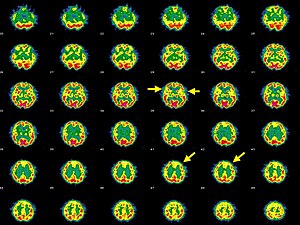Hashimoto encephalopathy
| Hashimoto's encephalopathy | |
|---|---|
 |
|
| Brain SPECT transaxial images of a patient afflicted with Hashimoto's encephalopathy. | |
| Classification and external resources | |
| Specialty | neurology |
| ICD-10 | Xxx.x |
| ICD-9-CM | xxx |
Hashimoto's encephalopathy, also known as steroid responsive encephalopathy associated with autoimmune thyroiditis (SREAT), is a neurological condition characterized by encephalopathy, thyroid autoimmunity, and good clinical response to steroids. It is associated with Hashimoto's thyroiditis. It was first described in 1966. It is sometimes referred to as a neuroendocrine disorder, although the condition's relationship to the endocrine system is widely disputed. It is recognized as a rare disease by the NIH Genetic and Rare Diseases Information Center.
Up to 2005 there were almost 200 published case reports of this disease. Between 1990 and 2000 43 cases were published. Since that time, research has expanded and numerous cases are being reported by scientists around the world, suggesting that this rare condition is likely to have been significantly undiagnosed in the past. Over 100 scientific articles on Hashimoto's encephalopathy were published between 2000 and 2013.
A relapsing encephalopathy occurring in association with Hashimoto's thyroiditis, with high titers of anti-thyroid antibodies. Clinically, the condition may present one or more symptoms. Onset is often gradual and may go unnoticed by the patient and close associates to the patients. Symptoms sometimes resolve themselves within days to weeks, leaving a patient undiagnosed. For many other patients, the condition may result in ongoing problems with a variety of manifestations, often confusing clinicians due to the diffuse nature of symptoms.
The onset of symptoms tends to be fairly gradual and to occur over 1–7 days.
Symptoms of Hashimoto's encephalopathy may include:
The mechanism of pathogenesis is not known but it has been hypothesized to be an autoimmune disorder, similar to Hashimoto's thyroiditis as its name suggests.
Consistent with this hypothesis, autoantibodies to alpha-enolase have been found to be associated with Hashimoto's encephalopathy. Since enolase is the penultimate step in glycolysis, if it were inhibited (for example by being bound by autoantibodies) one would expect decreased energy production by each cell, leading to resulting atrophy of the affected organ.
...
Wikipedia
